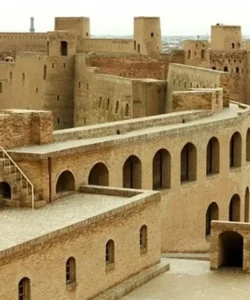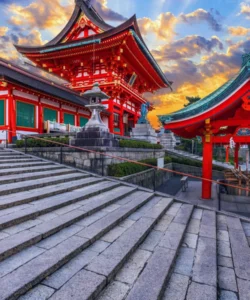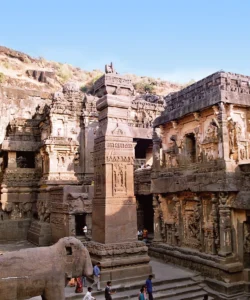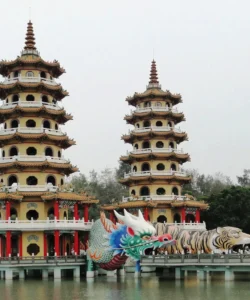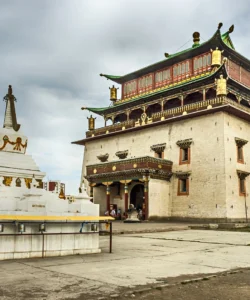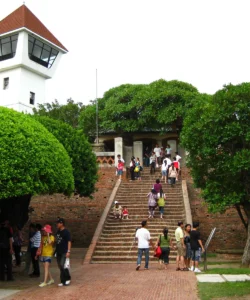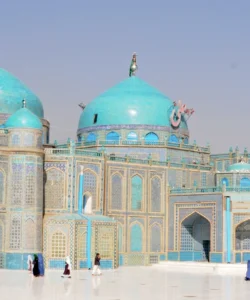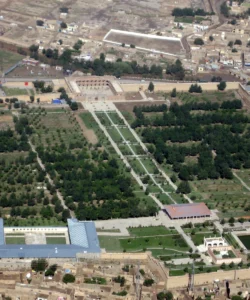The Archaeological Remains of the Bamiyan Valley are an extraordinary and deeply significant cultural landscape in the central highlands of Afghanistan. This UNESCO World Heritage site is a powerful testament to a vibrant ancient civilization at the crossroads of the Silk Road, renowned for its unique blend of artistic influences and its tragic recent history.
Name: Cultural Landscape and Archaeological Remains of the Bamiyan Valley
Address: Bamiyan Valley, Bamiyan Province, Afghanistan. The valley is located in the high mountains of the Hindu Kush, northwest of Kabul.
How to Get There:
Travel to the Bamiyan Valley is currently extremely difficult and unsafe for general tourism due to the political instability and security situation in Afghanistan. The following information is for historical context and is not a recommendation for travel.
- By Air: The closest airport is Bamiyan Airport (BIN). While domestic flights have operated to this airport from Kabul, their regularity and safety are uncertain.
- By Road: The drive from Kabul to Bamiyan is a long and challenging journey, taking several hours through mountainous terrain with significant security risks.
- Organized Tours: Prior to recent political events, a few specialized tour operators organized guided tours to the Bamiyan Valley from Kabul. However, such travel is currently not feasible for international visitors.
- UNESCO efforts: UNESCO has a presence in Afghanistan and has worked with local authorities on conservation and preservation efforts since the destruction of the Buddhas.
Landscape and Architecture:
The Bamiyan Valley is a breathtaking natural landscape, and its “architecture” is a magnificent display of rock-cut monuments, monasteries, and ancient fortifications that reflect centuries of artistic and religious development.
- The Bamiyan Cliffs: The most prominent feature of the valley is a long, high stretch of rocky cliffs. The numerous caves and niches carved into this cliff face form a vast ensemble of ancient Buddhist monasteries, sanctuaries, and living quarters for monks.
- The Buddha Niches: The most famous architectural features of the valley were the two colossal standing Buddhas of Bamiyan, carved into the cliffside in the 6th and 7th centuries CE. These monumental statues, standing at 55 meters (“Western Buddha”) and 38 meters (“Eastern Buddha”), were the largest standing Buddha carvings in the world. Tragically, they were deliberately destroyed by the Taliban in 2001. Today, the monumental niches in which they once stood serve as a haunting testament to their former glory and a symbol of their tragic loss.
- Cave Monasteries and Sanctuaries: Surrounding the Buddha niches are hundreds of smaller caves, which were once an extensive network of Buddhist monasteries, chapels, and sanctuaries. These caves were often decorated with vibrant murals and frescoes, showing a unique synthesis of Indian, Hellenistic, Roman, and Sasanian artistic influences.
- Fortresses and Fortified Settlements: The valley’s strategic position on the Silk Road led to the construction of fortifications and settlements from both the Buddhist and later Islamic periods.
- Shahr-i Ghulghulah: (City of Screams), a ruined fortress dating from the 6th to 10th centuries CE, marks the original settlement of Bamiyan.
- Shahr-i Zuhak: (The Red City), a fortress guarding the eastern entrance to the valley with remains dating from the 6th to 13th centuries.
- Archaeological Layers: The archaeological remains reveal a rich history of different eras, from the 1st to the 13th century, with layers of Buddhist monastic ensembles overlaid by fortified structures from the Islamic period.
- Cultural Landscape: The valley’s importance extends beyond its monuments. Its traditional land use and simple mud-brick constructions, set against the backdrop of the high mountains of the Hindu Kush, form a unique cultural landscape that reflects centuries of adaptation to the environment.
What Makes It Famous:
- The Buddhas of Bamiyan: The valley is globally famous for the two colossal Buddha statues that were tragically destroyed in 2001. Their destruction was an internationally condemned act that brought the site to global attention and made the empty niches a powerful symbol of cultural destruction and loss.
- UNESCO World Heritage Site: Designated a UNESCO World Heritage Site in 2003, it is recognized for being an exceptional testimony to the interchange of Indian, Hellenistic, Roman, and Sasanian influences, which formed the basis for the unique Gandharan school of Buddhist art.
- Crossroads of the Silk Road: Bamiyan was a vital and flourishing hub on the Silk Road, serving as a key center of trade and a crucial link for the spread of Buddhism from India into Central Asia and China.
- Remarkable Artistic Synthesis: The art and architecture of the Bamiyan Valley, particularly its murals and sculptures, are a unique synthesis of a wide range of cultural influences, making it an invaluable site for studying the history of art and religion in the region.
- Long History of Human Settlement: The valley has been inhabited since at least the 3rd century BCE, with a continuous history of monastic life, trade, and settlement until the Mongol invasion in the 13th century.
- A Symbol of Resilience: Despite the tragic destruction and centuries of conflict, the valley and its remaining archaeological sites stand as a testament to the resilience of a culture and its heritage, continuing to hold immense spiritual and national pride for the Afghan people.
- Global Heritage in Danger: The site is on UNESCO’s List of World Heritage in Danger, highlighting the ongoing threats from looting, erosion, and the challenges of conservation in the face of conflict and development pressures.
Differences from Some Other Wonders:
- Tragic Destruction and Haunting Absence: The most significant difference from other wonders is that the central, iconic monuments for which it was famous—the two giant Buddha statues—no longer exist. The site’s fame is now inextricably linked to the haunting absence of these monuments and the tragic story of their destruction, making it a unique kind of memorial and a powerful symbol of cultural loss.
- A “Living” Symbol of Conflict: The Bamiyan Valley is a site that carries a profound and very recent memory of conflict and deliberate cultural destruction, making it a “living” symbol of a global issue, a narrative that is less central to ancient sites that have simply fallen to natural decay or older conflicts.
- Synthesis of Influences on a Grand Scale: While other sites like Taxila also show Greco-Buddhist fusion, the Bamiyan Valley’s sheer scale of rock-cut monasteries, its monumental Buddha statues, and the breadth of influences (Indian, Hellenistic, Roman, Sasanian) make it an unparalleled example of this artistic synthesis.
- Focus on Rock-Cut Monasteries: While Borobudur is a monumental temple and Takht-i-Bahi is a monastic complex, Bamiyan is a vast cultural landscape centered on an entire network of rock-cut monasteries, caves, and monumental niches carved into a massive cliff face.
- History of Recurring Iconic Destruction: The destruction of the Buddhas in 2001 was not the first time they were attacked. They had been defaced by later Mughal emperors, showing a recurring theme of iconic reactions to the statues over centuries, adding another layer of historical context to their destruction.
- UNESCO “In Danger” Status: Its status on the List of World Heritage in Danger highlights its vulnerable and threatened condition, a crucial part of its identity and a call for global conservation efforts.
- Absence of Rebuilding Consensus: The debate around whether to rebuild the Buddhas or to leave the niches as a memorial to the destruction is a unique ethical and conservation issue that is part of its modern identity, unlike other sites where reconstruction is often a key goal.
Archaeological Remains of the Bamiyan Valley Photos:



























